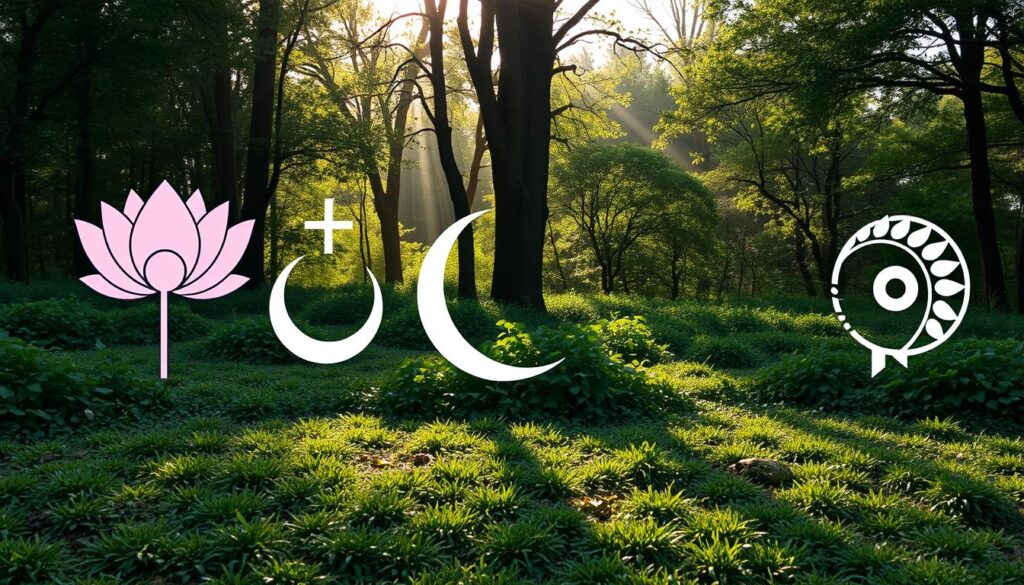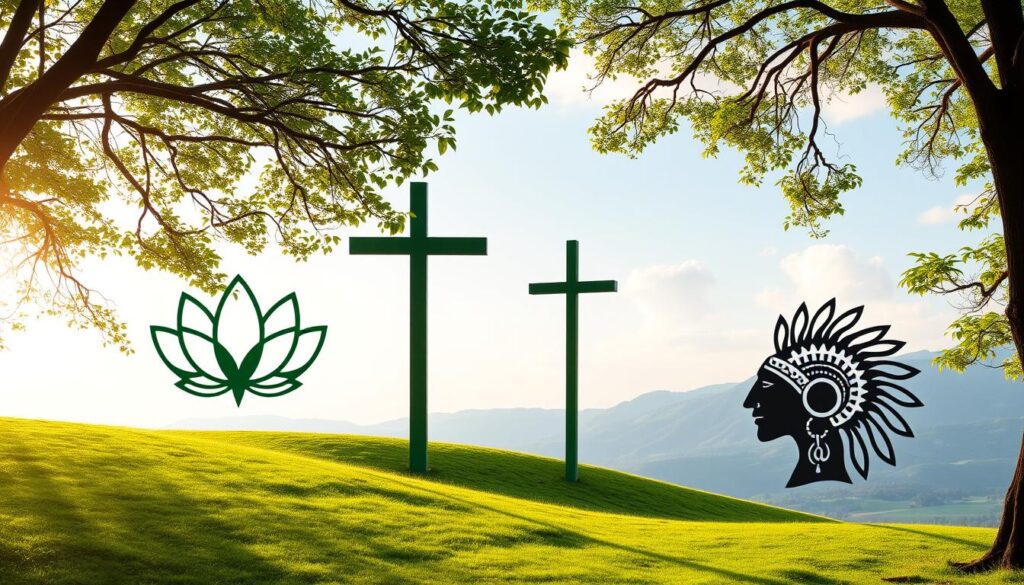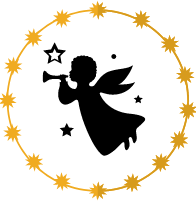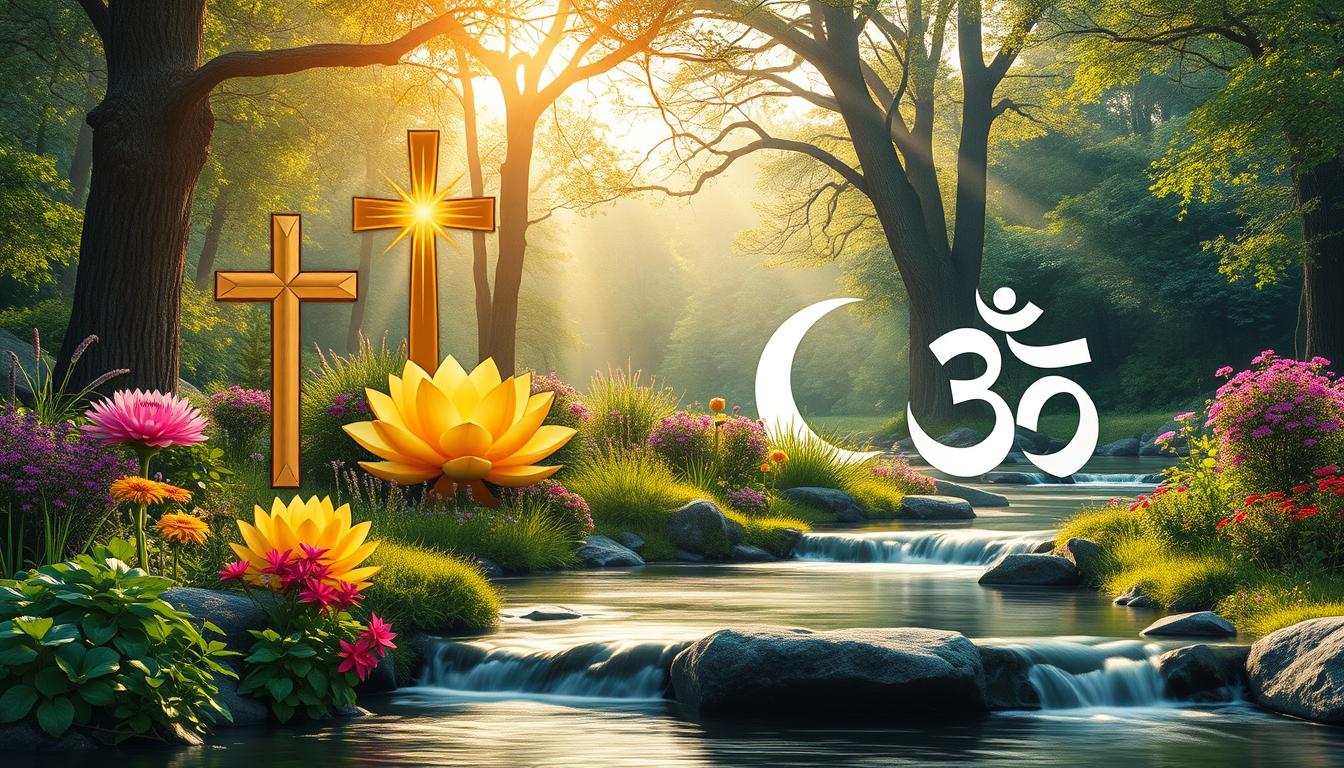Did you know that about 65% of Americans say they are “religious and spiritual”? This shows how big of a role religion and spirituality play in our lives. I’ve seen how these beliefs shape who we are and how we live together.
welcome to checkreligion.com
Religion Definition !
The meaning of religion is a mix of personal and group beliefs about the sacred and right and wrong. Experts have been trying to figure out what religion is for a long time. They see it as connected to ethics, big questions, and things beyond our world. Through my travels, I’ve learned how religion affects both communities and our personal lives.
Let’s dive into the world of religion together. We’ll explore its many sides and how it touches our lives in today’s world.
Key Takeaways
- 65% of Americans identify as both religious and spiritual.
- The definition of religion includes diverse beliefs about morality and the sacred.
- Christianity remains the largest religion, comprising about 31% of the global population.
- Spirituality is growing, especially in workplaces, with around 49% of employees identifying as spiritual.
- Daily spiritual practices, such as prayer and meditation, engage approximately 36% of Americans.

Introduction to Religion
Exploring religion, I find it key to define religion broadly. It’s a big part of human culture. It includes beliefs and many cultural aspects of religion that shape our world.
World religions like Judaism, Christianity, and Islam show us how diverse and complex it is. They help us see the richness of faith.
In this introduction to religion, I see how spiritual beliefs shape our society. Anthropologist Edward Burnett Tylor said religion is about believing in spirits. This helps us understand how different cultures have their own faiths.
Edward Herbert found five big ideas in all religions. These include believing in a supreme being and the importance of worship. These ideas bring people together, creating a sense of community.
William James also had a great idea. He said religion is about believing in something we can’t see. This makes people try to live in harmony with that unseen order.
There are about 10,000 religions in the world. The big four—Christianity, Islam, Hinduism, and Buddhism—cover over 77% of people. This shows how big of a role religion plays in our lives.
The Meaning of Religion
Religion is a mix of beliefs, practices, and values that have grown over time. It answers big questions about life and our place in the world. Scholars give us interesting views on what religion is.
R. N. Bellah says religion is about symbols that connect us to our deepest questions. Melford Spiro talks about superhuman beings and how they shape our beliefs and actions. These ideas help us see how faith gives us meaning and direction.
Clifford Geertz says religion uses symbols to create strong feelings and motivations. Many see football as a kind of religion because of the loyalty and emotions it brings. This shows religion can be more than just traditional beliefs.
Cicero looked into the word “religion” and found it means to bind people together. Gathering beliefs and connecting with others meets our need for meaning and belonging. Seeing how different cultures view religion helps us understand it better.
Religion has many meanings, showing it is always changing. It can be through rituals or ethical teachings. It helps many people find comfort and guidance in their lives.

Religion Definition
Religion is about many beliefs and practices. It deals with the supernatural and the meaning of life. It shows how personal beliefs and big systems work together.
These two parts shape the experiences of people in different religions. It’s interesting to see how they mix.
Personal Sets of Beliefs and Institutional Systems
Personal beliefs are the base of spirituality. Each person’s faith is unique. It shows how they see the divine and their morals.
Institutional systems help people feel part of a group. They offer a way to worship together. This is seen in religions like Christianity and Buddhism.
People can believe on their own but also join in with others. This is true for many religions.
Characteristics of Religious Practices
Religious practices show faith and bring people together. They include rituals, worship, and teaching morals. Rituals are special actions that make everyone feel connected.
Going to church or doing a Hindu puja are examples. These practices make each religion special. They can even be part of daily life, like food or community events.

Historical Perspectives on Religion
Looking back at history shows us how beliefs have changed over time. The word “religion” comes from the Latin religio. It means systems of belief that find the sacred or spiritual in cultures.
From the start, leaders used stories and symbols to add meaning to life. This helped communities come together.
Every culture around the world has some form of religion. People practice it openly with their groups. Rituals like funeral rites show how different cultures are.
These rituals weave a rich story of religious history. They show both common human experiences and unique cultural ways.
Important thinkers have helped us understand religion’s evolution. Karl Marx saw how religion shows society’s gaps. Émile Durkheim thought it was a way to bring people together. Max Weber believed it could change society, like how Protestant values helped capitalism grow.
Today, some say work is more important than religion in our lives. This shows how beliefs and society are connected. Looking at history, we see how religions like Christianity, Islam, and Hinduism have shaped the world.
Types of Religions Around the World
Exploring human spirituality shows us many religions. Major world religions have lots of followers and shape cultures. Folk and indigenous religions offer unique views on spirituality, tied to communities and lands.
Major World Religions
Major world religions have many beliefs and traditions. They have followers all over the world:
- Christianity: The biggest religion, with many denominations. It’s led by the Pope.
- Islam: Mostly Sunni Muslims, with Shia Muslims making up a smaller part. It follows the Prophet Muhammad’s teachings.
- Hinduism: From India, it has many gods and rituals.
- Buddhism: Based on Buddha’s teachings, it aims for spiritual enlightenment. It has different traditions like Theravada and Mahayana.
Folk and Indigenous Religions
Folk religions are special because they come from indigenous cultures. They have unique practices:
- Spiritual connection to the land: They believe nature is sacred.
- Community rituals: They celebrate local customs and festivals. This strengthens community bonds.
- Diverse belief systems: With over 4,200 religions, folk religions add to faith diversity.
Read Our more articles : Types of Muslims
Components of Religious Beliefs
The components of religious beliefs are the heart of many faiths. They touch the lives of millions. Each faith has key parts that guide its followers.
Doctrines are the main ideas of a religion. They are found in sacred texts like the Bible or Quran. These texts give followers a sense of purpose and understanding.
Moral codes are important too. They tell followers how to behave and make choices. Following these codes is a big part of being religious for many.
Community practices are also key. They help followers feel connected and share in worship. Being part of a community strengthens faith.
Even though religions share some ideas, they are different too. For example, some believe in one God, while others believe in many. This shows how rich and varied human experiences are.
Here’s a table showing some big religions and their followers. It also lists what makes each faith special:
| Religion | Adherents (in millions) | Core Components |
|---|---|---|
| Christianity | 2100 | Doctrinal beliefs, scripture (Bible), communal worship |
| Islam | 1500 | Five Pillars, Quran, community prayer |
| Hinduism | 900 | Vedas, karma, dharma, diverse deities |
| Buddhism | 376 | Four Noble Truths, Eightfold Path, meditation |
| Judaism | 14 | Torah, covenant, ethical teachings |
| Secular/Non-Religious | 1100 | Varied beliefs, cultural ethics, no formal practices |
This look at components of religious beliefs shows how diverse and complex faiths are. Knowing these parts helps us understand and respect different beliefs.
Spiritual Practices and Beliefs
Spiritual practices help people show their beliefs and connect with their faith. These practices guide them on their journey to understand the divine and themselves. From old traditions to new views, spirituality shows up in rituals and worship. These acts help people feel part of something bigger and give them purpose.
Rituals and Worship
Rituals are key in many religions. They can be group events or personal acts. Each one is special for deepening connection and understanding. Some common rituals include:
- Going to worship services
- Celebrating big life events like weddings and funerals
- Enjoying seasonal festivals and holidays
- Doing daily things like lighting candles or praying
These rituals tie people to their religious roots. They also help people explore their own spirituality. Many find these practices help them understand their place in the world.
Prayer and Meditation
Prayer and meditation are key for growing spiritually. They help people feel close to the divine, bringing peace and connection. Prayer lets people share their thoughts, hopes, and thanks. Meditation helps them look inside and grow.
Prayer and meditation can bring many benefits. They can:
- Clear your mind and calm your emotions
- Bring inner peace
- Make you more mindful and aware
- Help you reflect and improve yourself
Doing these practices can make you feel better and connect with others spiritually. They are important for anyone wanting to deepen their spiritual connection.
| Practice Type | Description | Benefits |
|---|---|---|
| Rituals | Structured ceremonies or actions performed regularly | Fosters community connection, strengthens faith |
| Prayer | Prayer is a personal conversation with the divine | Promotes emotional comfort, clarity of mind |
| Meditation | Practice of focused thought to promote awareness | Enhances inner peace, encourages personal insight |
Defining Religious Tradition and Doctrine
Exploring religious tradition and doctrine shows us two paths that shape our faith. Traditions are shared practices, stories, and symbols that make a community’s spirit strong. They connect us to our past and guide us today.
For example, the Roman Catholic Council of Trent from 1545 to 1563 helped shape some traditions in that faith.
Doctrine, on the other hand, is a clear set of beliefs that help us on our spiritual path. Dogma, or doctrine, is like a rule that tells us what to believe. It helps us understand the basics of faith.
Karl Rahner, a Roman Catholic scholar, saw dogma as key to the church’s faith. He believed it stays important even as we see things differently over time.
Traditions also change and grow. St. Anselm of Canterbury said theology is about finding reason in faith. This shows how faith and reason work together, making our beliefs strong and flexible.
In many cultures, funeral rites and other practices are deeply rooted in faith. Feasts, festivals, and art add to these traditions. They help communities come together and find spiritual meaning.
Religion and work also go hand in hand, especially in capitalist societies. The Protestant work ethic is a great example. It shows how faith can drive progress in society.
Looking at tradition and doctrine, we see how they shape us as individuals and communities. They help us understand our place in history and culture. This deepens our respect for faith and its role in our lives.
The Role of Faith in Religion
Faith is key to understanding religion and who we are. It helps us find meaning, feel connected, and know our purpose. Faith is more than just believing in certain ideas. It’s about our personal beliefs and the ways we act together in our communities.
In Christianity, there are over 38,000 different groups. Each has its own way of seeing faith. For example, Orthodox Christianity has its own practices but still believes in Jesus Christ. This shows how faith can unite people, even when they disagree.
But faith isn’t just for Christians. Judaism, Buddhism, and Islam also have deep faith systems. These faiths show how belief can shape our lives and bring us together.
Faith and reason work together to help us through tough times. Faith can give us strength and help us keep going. It’s about finding hope and growing through our experiences.
Philosophers have many views on faith. Some try to understand it by breaking down words. Others look for ways to make faith fit with our lives. This shows faith is not just a belief. It’s something we live every day.
Conclusion
In this summary of religion, we looked at the layers of beliefs and practices. We saw how religion is a big part of who we are. It has changed a lot over thousands of years.
From old burial practices to today’s spiritual ways, religion shows us how to connect with others. It helps us understand and care for each other, no matter who we are.
Thinking about religion, we see it’s more than just old stories and rules. It helps us talk and connect in our world today. It teaches us to be kind, hopeful, and to share values.
By learning about different beliefs, we find our purpose and do good in the world. This is very important for us all.
Today, religion is key in fighting against just focusing on money and stuff. It teaches us to care for others and live with meaning. It helps us see our lives as part of something bigger and more important.
FAQ
What is the definition of religion?
Religion is a mix of beliefs, practices, and values. It often deals with the sacred and moral principles. It answers big questions and is shaped by personal and group experiences.
How do personal beliefs relate to organized religion?
Personal beliefs are the base of an individual’s faith. Organized religion adds structure and support. Together, they help understand spirituality and moral living.
What are some common characteristics of religious practices?
Religious practices include rituals, worship, moral codes, and community meetings. These activities strengthen beliefs and unite people in faith.
How has religion historically evolved?
Religion has grown from old beliefs to today’s complex systems. It has been shaped by cultural changes, key figures, and important events.
What are the major world religions?
Major world religions are Christianity, Islam, Hinduism, and Buddhism. Each has its own beliefs, practices, and cultural effects, making the world’s spirituality diverse.
What components make up religious beliefs?
Religious beliefs include doctrines, sacred texts, moral codes, and community practices. These elements form a system that guides followers’ lives.
What role do rituals play in spirituality?
Rituals express faith and structure spiritual lives. They include group worship and personal devotion. They help believers connect with the divine and grow spiritually.
What is the difference between religious tradition and doctrine?
Tradition is about practices and customs in a faith. Doctrine is about beliefs and teachings that guide followers. Both shape faith and community life.
Why is faith essential in religion?
Faith is key as it defines an individual’s spiritual identity. It guides beliefs and experiences. It’s crucial for building community, personal strength, and growth in faith.

